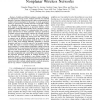Free Online Productivity Tools
i2Speak
i2Symbol
i2OCR
iTex2Img
iWeb2Print
iWeb2Shot
i2Type
iPdf2Split
iPdf2Merge
i2Bopomofo
i2Arabic
i2Style
i2Image
i2PDF
iLatex2Rtf
Sci2ools
134
Voted
INFOCOM
2007
IEEE
2007
IEEE
Face Tracing Based Geographic Routing in Nonplanar Wireless Networks
— Scalable and efficient routing is a main challenge in the deployment of large ad hoc wireless networks. An essential element of practical routing protocols is their accommodation of realistic network topologies. In this paper, we study geographic routing in general large wireless networks. Geographic routing is a celebrated idea that uses the locations of nodes to effectively support routing. However, to guarantee delivery, recent geographic routing algorithms usually resort to perimeter routing, which requires the removal of communication links to get a planar sub-network on which perimeter routing is performed. Localized network planarization requires the wireless network to be a unit-disk graph (UDG) or its close approximation. For networks that significantly deviate from the UDG model, a common case in practice, substantially more expensive and non-localized network planarization methods have to be used. How to make such methods efficiently adaptable to network dynamics, and...
Related Content
| Added | 03 Jun 2010 |
| Updated | 03 Jun 2010 |
| Type | Conference |
| Year | 2007 |
| Where | INFOCOM |
| Authors | Fenghui Zhang, Hao Li, Anxiao Jiang, Jianer Chen, Ping Luo |
Comments (0)

